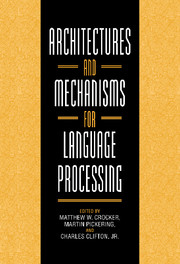Book contents
- Frontmatter
- Contents
- Contributors
- Preface
- 1 Architectures and Mechanisms in Sentence Comprehension
- Part I Frameworks
- 2 Evaluating Models of Human Sentence Processing
- 3 Specifying Architectures for Language Processing: Process, Control, and Memory in Parsing and Interpretation
- 4 Modeling Thematic and Discourse Context Effects with a Multiple Constraints Approach: Implications for the Architecture of the Language Comprehension System
- 5 Late Closure in Context: Some Consequences for Parsimony
- Part II Syntactic and Lexical Mechanisms
- Part III Syntax and Semantics
- Part IV Interpretation
- Author Index
- Subject Index
2 - Evaluating Models of Human Sentence Processing
Published online by Cambridge University Press: 03 October 2009
- Frontmatter
- Contents
- Contributors
- Preface
- 1 Architectures and Mechanisms in Sentence Comprehension
- Part I Frameworks
- 2 Evaluating Models of Human Sentence Processing
- 3 Specifying Architectures for Language Processing: Process, Control, and Memory in Parsing and Interpretation
- 4 Modeling Thematic and Discourse Context Effects with a Multiple Constraints Approach: Implications for the Architecture of the Language Comprehension System
- 5 Late Closure in Context: Some Consequences for Parsimony
- Part II Syntactic and Lexical Mechanisms
- Part III Syntax and Semantics
- Part IV Interpretation
- Author Index
- Subject Index
Summary
The field of sentence parsing is currently blessed with intriguing theories of human sentence processing and with theorists who defend their theories with enthusiasm and dedication. This is far better than it was at the beginning of serious research into sentence parsing. The theory of derivational complexity was the best thing going, but it was a constantly moving target, whipping from one position to another as linguistic theory changed, and it always seemed possible to shoot it down wherever it went (see Gough & Diehl, 1978).
Things didn't get much better in the early 1970s, with the development of detective models of human sentence parsing (Fodor, Bever, & Garrett, 1914). Parsing theory was reduced to a list of “clues” that the parser might search for, and from which it might, in an associationistic fashion, project what kind of sentence it might be processing. Experimental research was dull, little more than the demonstration that this or that surface feature of sentences had something to do with comprehension (see Clark & Clark, 1977).
A turn for the better came in the mid-1970's with Kimball's principles (Kimball, 1973). Here were some explicit, economical statements of parsing preferences and decision rules that might have some broad applicability – something better than “look for a noun phrase after a transitive verb.” Frazier (1979) brought this approach to a new maturity with her proposal that a pair of strategies could account for a wide range of the phenomena that had previously been accounted for in only an ad hoc fashion.
- Type
- Chapter
- Information
- Architectures and Mechanisms for Language Processing , pp. 31 - 55Publisher: Cambridge University PressPrint publication year: 1999
- 1
- Cited by



